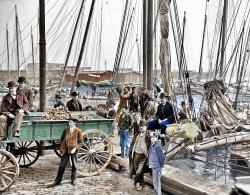
MAY CONTAIN NUTS

Search Shorpy
SHORPY ART

Framed or unframed, desk size to sofa size, printed by us in Arizona and Alabama since 2007. Explore now.
Join and Share
Ad-Free Shorpy
Shorpy is funded by you. Patreon contributors get an ad-free experience.
Learn more.

Recent comments
- Side Winder
- Air Quality?
- Sojourner Truth riot
- None were so blind(ed)
- The less famous sister
- Good ol' days?
- Rise and Fall
- Goo Goo Ga Joob
- Ticket Retention
- Not the only one
- Vagaries of War
- Killed by Amtrak
- Back to the Future
- Wanted --
- If you can't stand the light
- Centralized Traffic Control, I believe
- What's really happening
- Heckuva remote control!
- Sometimes — Things Go Bump!
- I SEE THE LIGHT
- Union Switch and Signal Company
- Get That Light Out Of My Eyes
- Eggs. Eggs. Eggs. The Egg Man is Here!
- Foreboding caption
- Famous Hollywood faces
- Not just S&P
- re: Those things in the jar
- Up In Smoke
- Medical Smoking
- Quick fix
Member Photos
The Shorpy
Print Emporium
Print Emporium
Search Shorpy
Search results -- 30 results per page
- All Aboard: 1919
- ... tell the poles apart. On the next track is a Washington, Baltimore & Annapolis Electric Railway interurban car, which is really ... play musical poles if it's going to Annapolis, instead of Baltimore, Maryland.
(The Gallery, D.C., Natl Photo, Streetcars) ... Posted by Dave - 09/17/2014 - 10:25am -
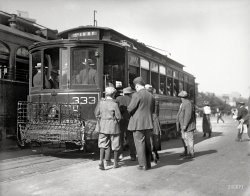
- Turbine Hall: 1930
- ... dam was about an hour north of our Baltimore home and I was always happy to go there not just for the fishing but ... Posted by Dave - 05/10/2016 - 7:38pm -
![Turbine Hall: 1930 Maryland circa 1930. "Conowingo Hydroelectric Plant. Turbine hall, seven turbines in Line II." 8x10 nitrate negative by Theodor Horydczak. View full size.
AMERICAN industrail craftsmanship at it's finestA standout in the modern world of plastic, precast concrete and particle board. And still generating clean and green power in 2016.
[Back when we could spell! - Dave]
Turbine Failures?Odd that there are two versions of turbine mixed in this row of seven.
The first, fourth, and fifth turbines have a rounded top on the exciter, more ventilating holes, and much beefier 6 legged bases. The other four have flat topped exciters and lower eight legged bases. The general design looks like all seven are from the same manufacturer, but built at different times.
[Four were built by General Electric and three by Westinghouse. - Dave]
AC TurbinesAllis Chalmers, that is.
The generators were GE and Westinghouse as Dave states. All seven turbines were manufactured by A.C.
http://www.michaelgatti.com/photos/2013/conowingo_dam/pages/page_19.html
Dam Good Fishing Spot
Conowingo Dam was one of my father's and uncles' favorite fishing spots. It always started early in the morn way before sunup since it was an accepted fact you had to be at your spot when the fish woke up for breakfast.
The dam was about an hour north of our Baltimore home and I was always happy to go there not just for the fishing but the thrill of riding over the dam and the mighty Susquehanna River.
The fishing was usually good (perch, small mouth bass, shad and rockfish) but I was always impressed by the huge mass of concrete upriver and the enormous floodgates.
I always hoped to see them open at once as seen in the pic below but the most I ever saw was one open gate.
(The Gallery, Industry & Public Works, Theodor Horydczak)](https://www.shorpy.com/files/images/SHORPY-5a48368u.thumbnail.jpg)
- Bottomley's Berry Farm: 1909
- ... Farm, Rock Creek. They all work in the berry fields near Baltimore in summer and have worked at Biloxi, Mississippi, for two years." ... Posted by Dave - 11/06/2013 - 9:52am -
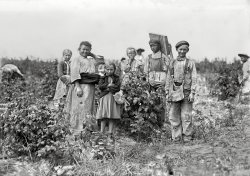
- Farm Fresh: 1917
- ...
Cabbages from the Atlantic seaboard states south of Baltimore are shipped either in crates or ventilated barrels holding 2¾ ... Posted by Dave - 01/02/2014 - 10:53am -
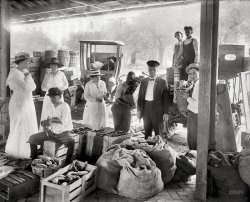
- Cathedral Place: 1906
- ... spooky. New Orleans is another such place. Maybe Baltimore, too.
But I've been fascinated from Day One by coquina buildings, ... Posted by Dave - 01/28/2020 - 1:55pm -
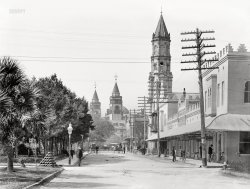
- Corner Grocery: 1921
- ... corner stores were commonplace in the East. I grew-up in Baltimore during the 1940/50s.
On two blocks of Frederick Ave in SW Balto, ... Posted by Dave - 07/17/2014 - 7:56am -
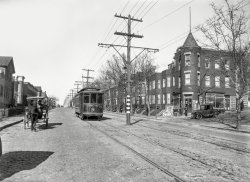
- Let's Roll: 1926
- ... the Washington team will meet an all-star combination from Baltimore. Skating will be permitted both before and after the game.
If ... Posted by Dave - 09/22/2012 - 12:09am -
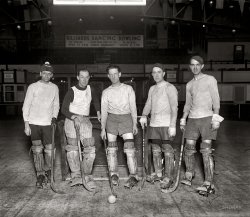
- Sandwich Depot: 1906
- ... front is still there, thankfully.
Relay Mail II In Baltimore in the late 40's and early 50's I remember the postmen boarding the ... Posted by Dave - 04/29/2015 - 9:13am -
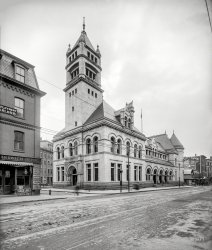
- Old King Coal: 1925
- ... with a location over the main tracks of the Philadelphia, Baltimore and Washington Railroad
.
A 1924 advertisement (also shown ... Posted by Dave - 09/12/2011 - 2:29pm -
![Old King Coal: 1925 Another view from 1925 of the W.H. Hessick & Son coal yard in Northeast Washington, D.C. By December 1925, the company had moved to 14th and Water Streets S.W. National Photo Company Collection glass negative. View full size.
W.H. Hessick coal yardDave, I think these photos of are of the Hessick Coal yard at 14th and Water streets S.W. Three reasons:
If these photos were of of facilities at 53-59 N sreet N.E., why would the sign have to include the information regarding the location of the office?
Consulting the 1919-1921 Baist Realty Maps, the orientation of the pictured sidings corresponds very well with a coal yard at 14th and Water streets S.W. (shown below). The maps of the area at 53-59 N sreet N.E, while close to the B&O tracks, shows no coal yard or similar sidings. In addition to the general track layouts, two additional details seem to fit with this location: The Bradley School was located at 13 ½ & D streets S.W. and could be the building visible in the background (under the gantry crane) of the earlier photo; The signal bridge shown in this photo is consistent with a location over the main tracks of the Philadelphia, Baltimore and Washington Railroad
.
A 1924 advertisement (also shown below) displays a line of trucks in front of what appears to be the facilities at 53-59 N St N.E. It is not the clearest image but the buildings and signage appear quite different from these photos.
(click on images for larger versions)
[The company's advertising prior to December 1925 has the coal yards on N Street N.E. The map below, from 1919, shows numerous coal yards and sidings there. The yard would have the address sign because it's east of the main office. Click to expand. - Dave]
(The Gallery, D.C., Natl Photo, Railroads)](https://www.shorpy.com/files/images/31760u_0.thumbnail.jpg)
- Last Rites: 1968
- ... of history passed me.
Just off North Point Blvd in Baltimore the funeral train rode by a crowd similar to the one above and ... Posted by Dave - 06/15/2019 - 12:11pm -
![Last Rites: 1968 June 8, 1968. "Funeral cortege of Robert F. Kennedy." Mourners viewing RFK's funeral train as it made its way from New York to Washington after his assassination. 35mm Kodachrome from photos by Paul Fusco and Thomas Koeniges for Look magazine. View full size.
In a Prosaic Industrial Park... a piece of history passed me.
Just off North Point Blvd in Baltimore the funeral train rode by a crowd similar to the one above and because of backlighting coming through the windows I caught a glimpse of people in the car, the casket and someone bending over and looking down at it. My sister and I both believe the person bending was Robert Kennedy.
[Um, Robert Kennedy is the guy *in* the casket, so probably not! - Dave]
It's an image burned onto my retina and all I have to do to remember that moment is close my eyes and I can feel the sense of loss the whole country and that bending figure felt at the time.
(We knew who was in the casket but we both to this day think it looked like Robert Kennedy. Twilight Zone Time? Mass Hysteria? Wishful Thinking?
There is a book that collects the photos from this journeyIt's very moving. Can be found on Amazon.com and elsewhere;
RFK Funeral Train by Paul Fusco
https://www.amazon.com/RFK-Funeral-Train-Paul-Fusco/dp/1884167047
Selection of photos here, too:
https://www.magnumphotos.com/newsroom/politics/paul-fusco-rfk-funeral-tr...
(Kodachromes, Cars, Trucks, Buses, LOOK, Railroads)](https://www.shorpy.com/files/images/SHORPY-11741u.thumbnail.jpg)
- Santa Monica: 1954
- ... I remember doing this dance across the downtown streets of Baltimore in the early 50's. As matter of fact Mom could be pulling me across ... Posted by dclark26 - 12/14/2011 - 2:08pm -
![Santa Monica: 1954 This was tried for a few years. When it was time to walk everyone took off in any direction to get to the other side. Never did hear of the mortality rate with that new brainstorm. View full size.
ScrambleI remember this system being in use at many intersections in downtown San Francisco when, in the 1954ish period, I'd accompany my mother on shopping trips. It was called "scramble" then, and a quick search finds that it's still the term where it's in use. If you can believe Wikipedia, there are still a few in SF and and in some other US cities. The disadvantage isn't about pedestrian safety, as vehicles on both streets have a red, but in the potential increase in vehicular congestion.
Square dance It's being introduced here in Adelaide, South Australia as the 'Square Dance' intersection. I don't know if it's been used here before, certainly not since I started driving in the '70s.
It seems effective to protect those pedestrians that seem to get 'simpler' every year from the drivers who were 'simple' to begin with.
The Barnes DanceI remember doing this dance across the downtown streets of Baltimore in the early 50's. As matter of fact Mom could be pulling me across Lexington Street in this photo.
"Catty-cornered"This was the way my hometown traffic signals operated. People didn't wander aimlessly into intersections, however; there was always a tidy march either straight across the street or diagonally, which was called "catty-cornered." That's a term I haven't heard in years.
[It's a colloquialism for "catercornered." - Dave]
(ShorpyBlog, Member Gallery)](https://www.shorpy.com/files/images/3rd._and_Santa_Monica_Blvd._1954_Diagonal_Walking.thumbnail.jpg)
- Trailer Talk: 1943
- ... 1943. "Middle River, a small crossroads in the vicinity of Baltimore, Maryland. Farm Security Administration housing project for Martin ... Posted by Dave - 07/09/2015 - 12:00pm -
![Trailer Talk: 1943 August 1943. "Middle River, a small crossroads in the vicinity of Baltimore, Maryland. Farm Security Administration housing project for Martin aircraft workers. Mrs. Helen Bird, USO traveler's aide, giving information to a newcomer in the Glenn L. Martin trailer village." Photo by John Collier. View full size.
Oooh, that smell!I can smell that trailer right now. The wood, canvas, varnish, rubber, books, and fabric. No plastics or synthetics. That's the smell of my early childhood.
FlooringThat linoleum bears a strong resemblance to the kitchen flooring of my youth. It looked like an explosion in a paint factory. As a young adult, I gave it the moniker 'Brain Damage'.
[It also looks like our kitchen floor, which was already in place when I was old enough to start noticing things in the mid-50s.]
(The Gallery, John Collier, WW2)](https://www.shorpy.com/files/images/SHORPY-8d32255a.thumbnail.jpg)
- Civil War Refugees
- ... 9, 1865 and as soon as they could, they traveled north to Baltimore in Maryland. William was born there in 1869 and John, the youngest, ... they moved again to Westminster, Maryland, just outside Baltimore. The effects of living through those war years shows especially in ... Posted by microanne - 03/23/2011 - 10:12am -
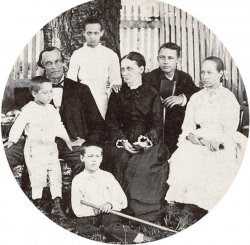
- Doris and Dot: 1943
- ... Doris and Dorothy Bell send and receive telegrams from the Baltimore circuit." If only Doris had been named Dash. Photo by Esther Bubley ... Posted by Dave - 02/12/2014 - 12:18pm -
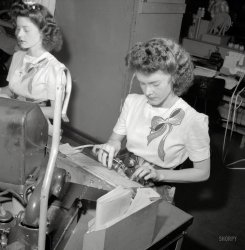
- The Front Porch: 1941
- October 1941. "House in New Baltimore on the Hudson, New York." Photo by John Collier for the Resettlement ... Posted by Dave - 10/09/2012 - 9:14pm -
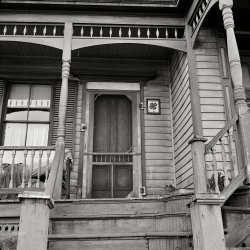
- Easter Sunday: 1945
- ... in front of Sacred Heart Of Jesus Chruch in Highlandtown, Baltimore, Md. My grandfather was a steelworker and was employed at the ... because they were underage. It made the front page of the Baltimore News American paper. View full size.
(ShorpyBlog, Member ... Posted by Son Of Highlandt... - 04/11/2011 - 8:53am -
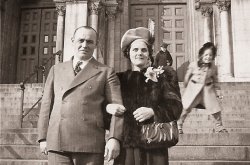
- Boompy's Bike: c. 1920
- ... Bernard J. "Boompy" Logue of 2527 E. Monument St. in Baltimore, MD, about 1920, on his home made bicycle. View full size.
... Posted by hoteldennis - 03/31/2011 - 10:03am -
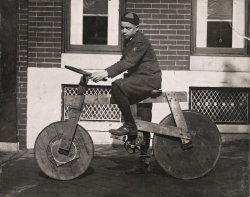
- Up First: 1901
- ... of E Street S.W., looking north up First Street showing Baltimore and Mitchell Book & Job Printers." 5x7 inch glass negative. ... Posted by Dave - 08/30/2020 - 11:55am -
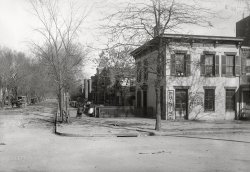
- Harry's Gone Fishing: 1939
- ... grandfather was a businessman who owned and operated an E. Baltimore roofing company established in 1906. But he loved fishing most of ... Roads, Virginia and brought to Bowley's Quarters in Baltimore County. He would go on the Chesapeake Bay a couple days a week when ... Posted by hippo - 07/18/2011 - 8:22am -
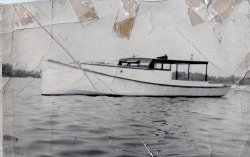
- Watch Your Step: 1933
- ... train, crushing the foot of William Covington, colored, Baltimore laborer. Covington was taken to Casualty Hospital ...
August ... Posted by Dave - 07/03/2014 - 4:58pm -
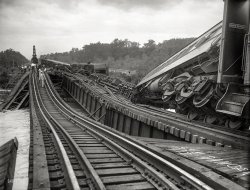
- The Great Fire
- ... album. Taken in Washington, D.C. [This is might be the Baltimore fire of 1904. Prints were sold as souvenirs in various cities. There ... Posted by woodwardave - 09/21/2011 - 9:21pm -
![The Great Fire From a turn-of-the-century family photo album. Taken in Washington, D.C. [This is might be the Baltimore fire of 1904. Prints were sold as souvenirs in various cities. There were also a few big fires in Arlington, Virginia, around that time. But none in Washington that I know of. - Dave] View full size.
MisnomerThe title was mine, judging by the size of the building that was leveled--sorry about any confusion. I don't think it was part of any larger fire. This is actually one out of a set of pictures.
WashingtonThis was the power company fire in D.C. Note the Chevy Chase Dairy wagon on the right.
(ShorpyBlog, Member Gallery)](https://www.shorpy.com/files/images/Untitled23shorpy1.thumbnail.jpg)
- The Sentinel: 1910
- ... Earlier than this was the monument to Washington, also in Baltimore. Both designed by Robert Mills.
The column/obelisk monument dates ... Posted by Dave - 01/20/2017 - 2:56pm -
![The Sentinel: 1910 Washington, D.C., circa 1910. "Washington Monument, looking west." 8x10 inch dry plate glass negative, Detroit Publishing Company. View full size.
What a spire!Yet I have always wondered why an obelisk would be associated with Washington, who wore curly wigs and buckle shoes. Whose idea was that design?
Answer lies in Wiki:
On September 23, 1835, the board of managers of the society described their expectations:[32]
It is proposed that the contemplated monument shall be like him in whose honor it is to be constructed, unparalleled in the world, and commensurate with the gratitude, liberality, and patriotism of the people by whom it is to be erected ... [It] should blend stupendousness with elegance, and be of such magnitude and beauty as to be an object of pride to the American people, and of admiration to all who see it.
EgyptWhy an obelisk? Earlier than this was the monument to Washington, also in Baltimore. Both designed by Robert Mills.
The column/obelisk monument dates back through Rome to Egypt (and earlier). When the Romans didn't want to build their own column, they'd pick up one or two from the Nile Valley and re-erect them thousands of miles away in Rome and, later, Constantinople. just to show their greatness.
Washington and the rest of the founding fathers consciously modeled their Republic on that of Rome. Since the US wouldn't have the technological capability to move an obelisk to the US until late in the 19th Century, they were stuck with building a symbol. The appropriate symbol in Rome for a great leader was the obelisk, so why not for the man who led and won the effort to re-establish the Republic of the ancient world in the new, and retired from office to allow power to pass on peacefully.
And what better way than to build the biggest obelisk the world had ever seen? We were typically American, even at the get go.
(The Gallery, D.C., DPC)](https://www.shorpy.com/files/images/SHORPY-4a25080a.thumbnail.jpg)
- Train Waving: 1967
- ... B&O line.
But by the early-sixties we had moved to Baltimore,MD and my train waving days were over. I had to console myself by ... Posted by AllenTenn - 02/08/2013 - 8:51pm -
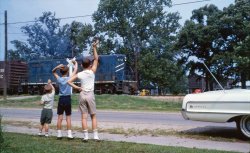
- Payday Fort Holabird: c. 1943
- Payday at Fort Holabird in Baltimore County-Dundalk Maryland some time around 1943. Considering the way ... Posted by hawkeye61 - 09/19/2011 - 9:53pm -
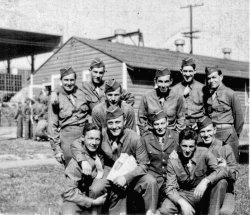
- Arundel Ice Cream c. 1942
- ... This Arundel Ice Cream was on 36th Street in Hampden, Baltimore Md. My grandmother, Myrtle Rassa, managed the store. She, my mother, ... Posted by Mrs. K - 08/31/2012 - 8:42pm -
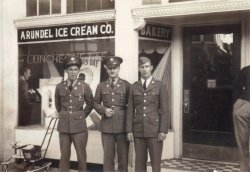
- Mae With Guitar
- ... This is Mae, the grandmother I never met. Taken near New Baltimore, Ohio.
1935 Terraplane The car your grandmother is standing ... Posted by chain - 04/14/2008 - 9:41pm -
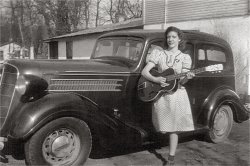
- Nifty 50s
- ... She is standing at the corner of Noble and Conkling St., Baltimore, Maryland. She was married and had no children. She was employed by ... Posted by Son Of Highlandt... - 03/01/2013 - 8:07pm -
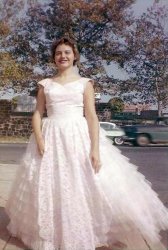
- Gable and Lombard: 1940
- Baltimore, Maryland. December, 1940. Fan snapshot of the famous couple near ... Posted by Sawney Beane - 07/25/2011 - 2:17pm -
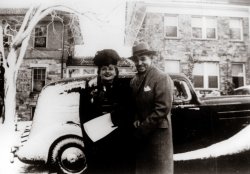
- Street Car: c. 1930
- ... out the window from delays in loading those crowds.
Baltimore had some; after the problems with them were discovered, they mostly ... Posted by GANDYLEE - 07/14/2011 - 7:31am -
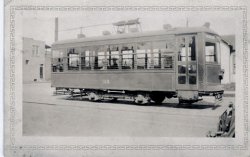
- The Oyster Wagon (Colorized): 1905
- ... at Shorpy.com. Great looking characters at the pier in Baltimore. View full size.
(Colorized Photos) ... Posted by friedadventures - 11/02/2012 - 7:44pm -
